Tigris river - Study guides, Class notes & Summaries
Looking for the best study guides, study notes and summaries about Tigris river? On this page you'll find 142 study documents about Tigris river.
Page 2 out of 142 results
Sort by
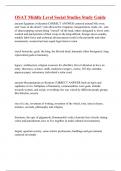
-
OSAT Middle Level Social Studies Study Guide
- Exam (elaborations) • 37 pages • 2023
- Available in package deal
-
- $14.49
- + learn more
ancient Egyptian civilization CORRECT ANSWER centered around Nile river, and "oasis in the desert," nile allowed for irrigation, transportation, trade, etc., sort-of sharecropping system (king "owned" all the land, others delegated it, lower sorts worked and paid portion of their crops to the king/official, foreign slaves usually, notable labor force and technical advancements result in the pyramids and other monuments, women had near-equal legal status to men social heirarchy: gods, the ...
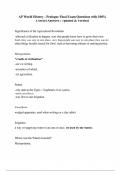
-
AP World History - Prologue Final Exam Questions with 100% Correct Answers | Updated & Verified
- Exam (elaborations) • 8 pages • 2024
-
Available in package deal
-
- $12.00
- + learn more
Significance of the Agricultural Revolution -allowed civilization to happen. now that people know how to grow their own food, they can stay in one place. now that people can stay in one place they can do other things besides search for food. such as becoming artisans or making pottery. Mesopotamia "cradle of civilization" -see 1st writing. -invention of wheel. -1st agriculture. Sumer -city state in the Tigris + Euphrates river system. -used cuneiform. -was first to use irrigation. Cun...
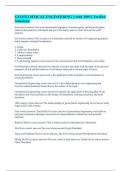
-
GEOTECHNICAL ENGINEERING || with 100% Verified Solutions.
- Exam (elaborations) • 7 pages • 2024
-
Available in package deal
-
- $10.59
- + learn more
Soil correct answers This is an uncemented aggregate of mineral grains and decayed organic matter (solid particles) with liquid and gas in the empty spaces (voids) between the solid particles. Soil correct answers This is used as a construction material in various civil engineering projects, and it supports structural foundations. 1. Origin 2. Grain-size distribution 3. Ability to drain water 4. Compressibility 5. Shear strength 6. Load-bearing capacity correct answers Six soil proper...

-
The Ultimate AP World History Set with Guaranteed Accurate Answers
- Exam (elaborations) • 151 pages • 2024
-
- $16.49
- + learn more
Mesopotamia - correct answer A region between the Tigris and Euphrates rivers that developed the first urban societies. In the Bronze Age this area included Sumer and the Akkadian, Babylonian and Assyrian empires, In the Iron Age, it was ruled by the Neo-Assyrian and Neo-Babylonian empires. Fertile Crescent - correct answer The Tigris and Euphrates Rivers gave life to the first known agricultural villages in this area about 10,000 years ago and the first known cities about 5,000 years ago. ...
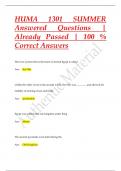
-
HUMA 1301 SUMMER Answered Questions | Already Passed | 100 % Correct Answers
- Exam (elaborations) • 77 pages • 2024
-
- $14.49
- + learn more
The river system that is the heart of ancient Egypt is called Ans: the Nile Unlike the other rivers in the ancient world, the Nile was ________ and allowed for stability of farming, food, and trade. Ans: predictable Egypt was unified into one kingdom under King Ans: Menes The ancient pyramids were built during the Ans: Old Kingdom A big difference between Mesopotamian religion and the Egyptian religion was the idea of Ans: an after life. Ra is the god of the Ans: sun. The Amarna ...

-
UTHS World History A
- Exam (elaborations) • 52 pages • 2024
-
- $11.99
- + learn more
UTHS World History A Select the most appropriate description of a nomadic tribe - group of people who traveled from location to location following herds of animals which provided food and clothing which of the following is a scientist that works to uncover artifacts physically unearthing these objects that the remains of people who created them - archaologist what period of history refers to the time when people did not leave written records - prehistory Mary Leakey's 1970s disco...

-
CSET subtest 1 (world history Exam Questions and Answers
- Exam (elaborations) • 10 pages • 2024
-
Available in package deal
-
- $14.49
- + learn more
Mesopotamia - Answer-tigris and euphrates river cuneiform (writing) organized gov. written law code (hammurabi's code) systemized religion (zoroastrianism) astronomy Egypt - Answer-Nile river, mediterranean and Red Sea religion of gods (pharaoh) writing (hieroglyphics) engineering (pyramids) mathematics India - Answer-Indus and Ganges rivers, Arabian Sea urban culture planned cities (sanitation system) Metallurgy (gold, copper, bronze) Measurement (weight, height, length, mas...
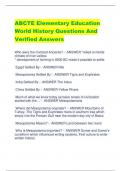
-
ABCTE Elementary Education World History Questions And Verified Answers
- Exam (elaborations) • 15 pages • 2023
- Available in package deal
-
- $12.99
- + learn more
ABCTE Elementary Education World History Questions And Verified Answers Who were the Civilized Ancients? - ANSWER *relied on fertile climate of river valleys * development of farming in 8500 BC made it possible to settle Egypt Settled By - ANSWER Nile Mesopotamia Settled By - ANSWER Tigris and Euphrates India Settled By - ANSWER The Indus China Settled By - ANSWER Yellow Rivers Much of what we know today as basic tenets of civilization started with the ... - ANSWER Mesopotamians ...
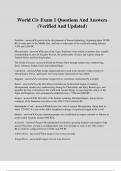
-
World Civ Exam 1 Questions And Answers (Verified And Updated)
- Exam (elaborations) • 5 pages • 2024
-
- $10.49
- + learn more
World Civ Exam 1 Questions And Answers (Verified And Updated) Neolithic - answera period in the development of human technology, beginning about 10,200 BC in some parts of the Middle East, and later in other parts of the world and ending between 4,500 and 2,000 BC. Mesopotamia - answerthe area of the Tigris-Euphrates river system, in modern days roughly corresponding to most of Iraq plus Kuwait, the eastern parts of Syria, and regions along the Turkish-Syrian and Iran-Iraq borders. The F...
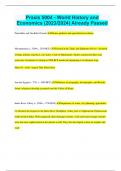
-
Praxis 5004 - World History and Economics (2023/2024) Already Passed
- Exam (elaborations) • 22 pages • 2023
- Available in package deal
-
- $9.99
- + learn more
Praxis 5004 - World History and Economics (2023/2024) Already Passed Paleolithic and Neolithic Periods Hunter-gatherer and agricultural revolution Mesopotamia (c. 3500-c. 2350 BCE) Formed at the Tigris and Euphrates Rivers - Invented writing, military expertise, city-states, Code of Hammurabi. Sumer constructed dikes and reservoirs. Invention of writing in 3500 BCE marks the beginning of civilization. Iraq Shatt Al - Arab - largest Date Palm forest Ancient Egypt (c. 2711-c. 1090 BCE) Influence...

$6.50 for your textbook summary multiplied by 100 fellow students... Do the math: that's a lot of money! Don't be a thief of your own wallet and start uploading yours now. Discover all about earning on Stuvia


